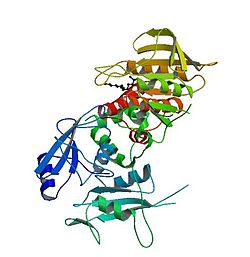PTPN11
| PTPN11 | |||||||||||||||||||||||||||||||||||||||||||||||||||
|---|---|---|---|---|---|---|---|---|---|---|---|---|---|---|---|---|---|---|---|---|---|---|---|---|---|---|---|---|---|---|---|---|---|---|---|---|---|---|---|---|---|---|---|---|---|---|---|---|---|---|---|
 | |||||||||||||||||||||||||||||||||||||||||||||||||||
| |||||||||||||||||||||||||||||||||||||||||||||||||||
| Identifiants | |||||||||||||||||||||||||||||||||||||||||||||||||||
| Aliases | PTPN11 | ||||||||||||||||||||||||||||||||||||||||||||||||||
| IDs externes | OMIM: 176876 MGI: 99511 HomoloGene: 2122 GeneCards: PTPN11 | ||||||||||||||||||||||||||||||||||||||||||||||||||
| |||||||||||||||||||||||||||||||||||||||||||||||||||
| |||||||||||||||||||||||||||||||||||||||||||||||||||
| |||||||||||||||||||||||||||||||||||||||||||||||||||
| |||||||||||||||||||||||||||||||||||||||||||||||||||
| |||||||||||||||||||||||||||||||||||||||||||||||||||
| Wikidata | |||||||||||||||||||||||||||||||||||||||||||||||||||
| |||||||||||||||||||||||||||||||||||||||||||||||||||
Le PTPN11 (pour « Tyrosine-protein phosphatase non-receptor type 11 »), ou SHP2, est une protéine tyrosine phosphatase. Son gène est le PTPN11 situé sur le chromosome 12 humain.
Rôles
Il comporte deux domaines SH2[5]. Ces derniers bloquent l'activité phosphatase de la molécule s'ils sont libres. S'ils sont activés, ils libèrent le site phosphatase permettant son action enzymatique[6].
Il régule la voie du phosphatidylinositol-3-phosphate[7].
En médecine
Une mutation du gène est retrouvée dans un cas de syndrome de Noonan sur deux ainsi que dans plusieurs cancers[8]. Ces mutations entraînent une augmentation variable (suivant la mutation[9]) de l'activité phosphatase, prolongeant le signal ERK2/MAPK1 facilitant une prolifération cellulaire[10]. Des mutations sont également retrouvées dans le syndrome LEOPARD[11].
Notes et références
- ↑ a b et c GRCh38: Ensembl release 89: ENSG00000179295 - Ensembl, May 2017
- ↑ a b et c GRCm38: Ensembl release 89: ENSMUSG00000043733 - Ensembl, May 2017
- ↑ « Publications PubMed pour l'Homme », sur National Center for Biotechnology Information, U.S. National Library of Medicine
- ↑ « Publications PubMed pour la Souris », sur National Center for Biotechnology Information, U.S. National Library of Medicine
- ↑ Feng G, SHP-2 tyrosine phosphatase: signaling one cell or many, Exp Cell Res, 1999;253:47–54
- ↑ Hof P, Pluskey S, Dhe-Pagganon S, Eck MJ, Shoelson SE, Crystal structure of the tyrosine phosphatase SHP-2, Cell, 1998;92:441–450
- ↑ Wu CJ, O’Rourke DM, Feng GS, Johnson GR, Wang Q, Greene MI, The tyrosine phosphatase SHP-2 is required for mediating phosphatidylinositol 3-kinase/Akt activation by growth factors, Oncogene, 2001;20:6018–6025
- ↑ Keilhack H, David FS, McGregor M, Cantley LC, Neel BG, Diverse biochemical properties of Shp2 mutants, J Biol Chem, 2005;280:30984–30993
- ↑ Niihori T, Aoki Y, Ohashi H et al. Functional analysis of PTPN11/SHP-2 mutants identified in Noonan syndrome and childhood leukemia, J Hum Genet, 2005;50:192–202
- ↑ Fragale A, Tartaglia M, Wu J, Gelb BD, Noonan syndrome-associated SHP2/PTPN11 mutants cause EGF-dependent prolonged GAB1 binding and sustained ERK2/MAPK1 activation, Hum Mutat, 2004;23:267–277
- ↑ Tartaglia M, Martinelli S, Stella L et al. Diversity and functional consequences of germline and somatic PTPN11 mutations in human disease, Am J Hum Genet, 2006;78:279–290
 Portail de la biologie cellulaire et moléculaire
Portail de la biologie cellulaire et moléculaire  Portail de la médecine
Portail de la médecine

















